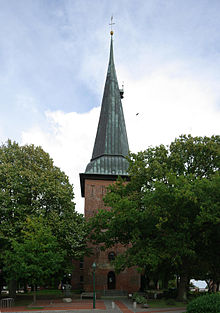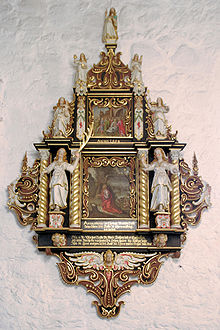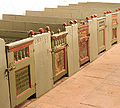St. Jacobi Church (Lüdingworth)
The St. Jacobi Church is one of the three peasant cathedrals in the Hadelner Land . It is located on the large Wurth in Lüdingworth , which was incorporated into Cuxhaven in 1972 . It is the most splendidly furnished of the three churches.
Building history
The field stone church in Romanesque style with a west tower was built around 1200. The parish was first mentioned in a document in 1298 . The hall choir was added around 1520 and brought into its current form in 1608/09. The wooden beam ceiling was added towards the end of the 16th century. The organ was completed in 1599 and replaced Matthias Mahn's previous instrument. The baroque interior now visible comes from the 17th and 18th centuries. Century. Since the market was also held here, an iron cubit is attached to the northern door of the choir to check the measurements.
The tower was renewed around 1520 by rebuilding it from brick. The wall thickness is 1.12 meters. In 1989/90 the entire tower foundation was renewed. The transition from the square basic shape of the tower to the octagonal shape of the spire is made by means of a wooden home pyramid. In 1933 a sandstone memorial plaque for the geographer Carsten Niebuhr (* 1733 Lüdingworth † 1815 Meldorf ) was placed on the north side.
In 1608, 36 sandstone panels were attached to the eastern outer wall below the choir window. These panels show the coats of arms of local farmers who were involved in the construction financially or through their own efforts. The two coats of arms of the sovereign are attached above these coats of arms.
Choir
The three-aisled choir connected to the nave by a round arch has a vaulted ceiling. The vault, which looks like a net vault, is a cross rib vault which is reinforced by additional ribs . The underlying cross vault rests on round pillars made of brick.
Furnishing
Baroque altar
The Lüderskooper altar was replaced by the current baroque altar in 1655. This has a brick cafeteria. It was built by Jörgen Heytmann , as can be seen from an inscription in the base ANNO 1655 / MEISTER JÖRGEN / HEYTMANN / BILTHAWER .
In the lower level of the altar the following four relief representations are executed as medallions : the Annunciation , the birth of Christ , circumcision and the three wise men . The midfield is divided into two parts. In the upper part there is a crucifixion with many figures, in the lower part the Last Supper is shown. To the left and right of the two middle pictures, separated by golden columns, there are two fully plastic figures. The left figure represents the patron saint St. Jacobus major , the right represents his brother John . In the middle level in the central picture the Ascension of Christ can be seen, flanked by the apostles Simon, with the saw as an attribute, and Matthias with the ax . The third level is a representation of the Last Judgment . The top is a fully plastic figure of the risen Jesus with the victory flag.
Lüderskooper altar
The first altar in the church is the three-part winged altar with pictures from the life of Mary, which is said to have previously stood in a chapel in Lüderskoop. This place is said to have been wiped out by the plague. It is not known when the chapel was pulled down.
The altar is two-winged and carved from linden wood. It dates from between 1430 and 1440 and was reworked in 1520. The open front is decorated with reliefs. The left wing shows the engagement of Mary to Joseph and the Annunciation , the center shrine to the Visitation , the birth of Christ , the offering of Jesus in the temple and the three kings . The flight to Egypt and the twelve-year-old Jesus in the temple are depicted on the right wing. The back of the wings were painted in 1620, the left wing shows the foundation of the Easter lamb, the right wing the washing of the feet.
pulpit
The pulpit stands exactly on the border between the nave and the choir. It dates from the beginning of the 17th century and was made by Michael Ringmaker and Johan Hoier, as the church chronicle tells us: Me. Ringmaker, de Bildensnider, and Johan Hoier, painter from Geversdorf.
Baptismal font
The bronze baptismal font dates from the beginning of the 14th century and stands over a fireplace to heat the baptismal water. It consists of four identical figures that carry the basin. The kettle itself is decorated with figural reliefs. In the upper of these two rings is written in mirror image : + Sit… Fons vivus aqva renans vda pvri . Above the basin is a hexagonal cover carved by Jörgen Heytmann, which is decorated with angel heads and grotesques. It is fastened with iron rods through the vault in the attic.
Epitaphs
The south wall of the church is decorated with three picture epitaphs. The first illustration on the left from 1668 shows the garden of Gethsemane. Representation two, donated in 1667, in the middle consists of two images. The upper one represents the Ascension of Christ, the lower the entry into Jerusalem. The third depiction, donated in 1671 and renewed in 1778, also shows two pictures, the upper one depicts the Conception of Mary, the lower Jesus in the temple. The fourth epitaph hangs on the north wall, donated in 1724, and shows the crucifix with Mary and John.
Pietà
The oak Pietà dates from the 15th century and depicts Mary with her dead son. The figure of Christ is missing the head, the right leg and the left arm.
Wooden beam ceiling
The wooden beam ceiling was drawn in at the end of the 16th century and is divided into 16 fields. Because of the size of the organ, the three western fields were broken through. The entire ceiling is painted and has the following motifs: Christ, the prophets and the Old Testament kings as well as peasant coats of arms are depicted in the round medallions. The spaces between these medallions are filled with flowers, fruits, grotesques and birds. The three fields above the organ are decorated in a technically inferior quality with banners and angels. In front of the west gallery with the organ hangs a trombone angel with a wingspan of two meters, which was carved by Jörgen Heytmann in 1660–1670 .
Tombstones
In the course of renovation work in 1990, three tombstones were embedded in the outer wall of the tower; they were previously in the churchyard. These 3 tombstones of historical interest have the following inscriptions
- Stein 1 Hävensche family , the picture is no longer recognizable
“Here in this grave the bones rest
The former mayor of this community Peter Hävensche born in the year of 1736 September 9th and his wife Margareta Hävenschen, a daughter of the mayor Cronen, who was once loved in life. She was born in 1735 on February 24th, 1755 on July 22nd in which she fathered 10 children as 8 sons and 2 daughters of which 1 son was still alive. The bliss in the gentleman fell asleep in 1784 on the 30th March of their age 49 years 1 month 4 days
A firm love bond linked us on earth, a grave surrounds us here until we become diseased here. "
- Stone 2 Family Oest A picture of the resurrection of Christ below
"Peter Oest Landschöpf Sel. Mrs. Marg. Elsiabeth Oest, born Otckens, fathered 10 children of which 1 son and 3 daughters in 1784. "
- Stone 3 Boitin family A Latin inscription under a large tree
“Dormitory Gerhard Boitini Pastor Parochiae Altenbr. et Margarethe Boitins eorumque haeredum "
Translated: Bedchamber of Pastor Gerhard Boitin of the Altenbruch parish and Margarethe Boitin and their descendants.
This pastor Boitin was born in Hamburg in 1651 and was pastor in Altenbruch from 1677 until his death in 1708. The churchyard on the Lüdingworhter Wurt was also used by some dignitaries from Altenbruch , as their own burial site was in danger of flooding.
organ
The organ was built by Arp Schnitger in 1682–1683 and the basic structure goes back to an instrument by Antonius Wilde from the years 1598–1599. The Rückpositiv and the two pedal towers break through the west gallery. With 35 registers , the organ has the largest inventory of registers of the Renaissance in Germany. In the years 1981–1982 the organ was completely restored by Jürgen Ahrend and the condition from 1683 restored.
Bells
In 1964, the renowned Otto bell foundry from Hemelingen / Bremen supplied a bronze bell with the strike tone d '. It has a diameter of 1392 mm and weighs around 1600 kg.
photos
literature
- Alfred Weckwerth: St. Jacobi Cuxhaven-Lüdingworth . In: Quick Art Guide . 8th edition. tape 869 . Schnell & Steiner, Munich 2004, ISBN 3-7954-4601-5 .
- The most beautiful "Bauerndom" , Heinz-Joachim Zinke, Hamburger Abendblatt, February 10, 2000.
Web links
- Website of the parish in the ev.-luth. Church district Cuxhaven-Hadeln
- Church on Stadtwiki Cuxhaven
- Organ in Lüdingworth at NOMINE e. V.
- Bells from St. Jacob, Ludingworth
Individual evidence
- ↑ Cornelius H. Edskes , Harald Vogel: Arp Schnitger and his work (= 241st publication by the Society of Organ Friends ). 2nd Edition. Hauschild, Bremen 2013, ISBN 978-3-89757-525-7 , pp. 30-32, 167 f .
- ^ Gerhard Reinhold: Otto bells. Family and company history of the Otto bell foundry dynasty . Self-published, Essen 2019, ISBN 978-3-00-063109-2 , p. 588, here in particular p. 560 .
- ↑ Gerhard Reinhold: Title = church bells - Christian world cultural heritage, illustrated using the example of the bell founder Otto, Hemelingen / Bremen . Nijmegen / NL 2019, p. 556, here in particular p. 514 , urn : nbn: nl: ui: 22-2066 / 204770 (doctoral thesis at Radboud University Nijmegen).
Coordinates: 53 ° 47 ′ 57.1 " N , 8 ° 45 ′ 32.4" E




















